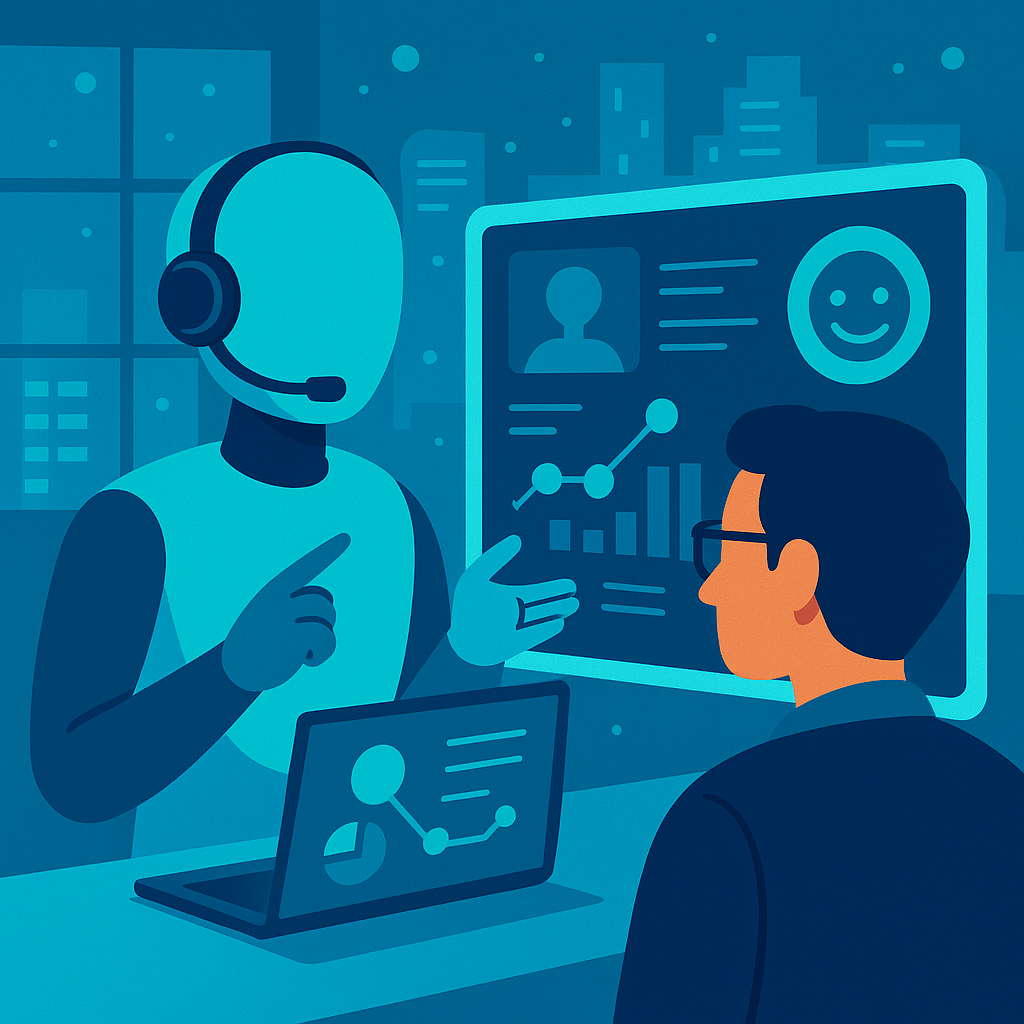How Agentic AI Is Transforming Customer Support


Table of contents
1 From chat‑bots to autonomous service agents
Traditional chat‑bots follow scripted flows. Large‑language‑model (LLM) assistants improved flexibility but still rely on the user's next prompt.
Agentic AI moves one layer higher: it receives a customer question, plans multi‑step actions (lookup warranty, trigger refund, schedule technician), invokes the right tools, self‑checks the outcome, and closes the ticket—all while talking naturally.
Result: faster resolutions, fewer hand‑offs, and significant cost savings.
2 Why customer support is the perfect beach‑head
| Driver | Impact |
|---|---|
| Structured data back‑end | CRMs, order systems, and knowledge bases give agents reliable APIs to call. |
| High transaction volume | Even 30 s shaved per ticket compounds into hours saved daily. |
| Clear success metrics | CSAT, FRT (first‑response time), AHT (average handle time) provide unambiguous ROI signals. |
| Talent pressure | Turnover in Tier‑1 support averages 35 – 45 %—automation eases hiring strains. |
3 Case studies: agentic AI in action
3.1 E‑commerce electronics retailer
Problem: Seasonal spikes flooded Tier‑1 agents; AHT hit 9 min.
Solution: Deployed an agent that (a) authenticates the shopper, (b) checks order status, (c) applies eligibility rules for refunds/exchanges.
Results (90 days):
- AHT ↓ 64 % (9 → 3.2 min)
- CSAT ↑ 8 points (from 78 → 86)
- Human agents redeployed to proactive upsell chat, adding 3 % revenue lift
3.2 Telecom provider – broadband outages
Problem: Outage tickets spiked call centre staffing; manual diagnostics took 6 min.
Solution: Agent integrates with network‑monitoring API, runs line tests, and initiates SMS comms; escalates only unresolved cases.
Results:
- First‑response time (FRT) now < 30 s 24/7
- 73 % of outage tickets close without human touch
- Annualised OpEx savings projected at $4.1 M
3.3 B2B SaaS – complex account queries
Problem: Customers asked contract, usage, and billing questions that spanned multiple teams.
Solution: Multi‑agent swarm—"PolicyBot," "BillingBot," "UsageAnalyst"—collaborate; a supervisor agent composes a unified answer and pushes it to Zendesk.
Results:
- 48 % reduction in inter‑team escalations
- Mean time‑to‑resolution (MTTR) down from 26 h → 7 h
- Human satisfaction scores unchanged—showing agent parity with expert reps
4 Implementation playbook
| Step | Actions | Deliverables |
|---|---|---|
| 1. Scope high‑volume intents | Analyse ticket logs; pick top 5 intents (e.g., order status, password reset). | Intent list + ROI baseline |
| 2. Map task graph | For each intent: data sources, API endpoints, decision rules, escalation triggers. | Annotated flow diagram |
| 3. Assemble tool stack | LLM (o3 / Claude 3), orchestrator (LangChain, crewAI), secure function calls, vector KB. | Dev environment + service accounts |
| 4. Pilot in shadow mode | Agent drafts responses; human approves. Iterate on failures. | ≥ 85 % draft‑success rate |
| 5. Add guard‑rails | Rate limits, cost caps, profanity & PII filters, human override. | Policy files, Slack alerts |
| 6. Phase rollout | 10 % traffic ➜ 50 % ➜ 100 %; continuous monitoring via Grafana/Prometheus. | Go‑live checklist & run‑book |
5 Governance & risk
| Risk | Mitigation |
|---|---|
| Hallucinated answers | Retrieval‑augmented generation (RAG) + confidence thresholds; low‑confidence answers auto‑escalate. |
| Sensitive data leakage | Strip PII before sending to LLM; encrypt logs; enforce role‑based access. |
| Cost overruns | Token budget per session; daily spend ceiling; alerts at 80 % usage. |
| Regulatory compliance | Log every tool call; keep audit trail for GDPR/SOC 2; periodic bias testing on sample tickets. |
6 KPIs that prove success
| Metric | Target | Why it matters |
|---|---|---|
| AHT | – 50 % within 60 days | Direct labour saving |
| FRT | under 30 s 24/7 | Customer expectation benchmark |
| Containment rate | ≥ 70 % self‑served | Measures autonomy |
| CSAT | + 5 pts or hold steady | Ensures quality doesn't drop |
| Escalation accuracy | ≥ 95 % of complex cases routed correctly | Protects Tier‑2 bandwidth |
7 The road ahead
- Proactive support agents – monitor usage patterns, open tickets before the customer notices an issue.
- Voice & multimodal – real‑time phone agents using synthesized voices + screen‑share guidance.
- Personalised CX – memory‑enhanced agents recall past conversations, preferences, and sentiment.
- Economic shift – support budgets transition from head‑count to "resolution‑as‑a‑service," aligning cost tightly with outcomes.
Final word
Customer support is no longer a cost centre to be tolerated—it's a data‑rich, automation‑ready arena where agentic AI can deliver faster resolutions, happier customers, and significant savings. By starting with clear intent clusters, building robust guard‑rails, and tracking the right metrics, organisations can deploy autonomous support agents that rival human expertise—24 / 7, at a fraction of the cost.
Have questions about implementing agentic support in your environment? Reach out for a tailored assessment or join our upcoming webinar on AI‑driven customer experience.

About the Author
Sai Venkata Sravan is a Machine Learning Engineer at QuantumVerse AI, specializing in AI-driven customer support systems. With expertise in developing intelligent automation solutions, he helps organizations transform their customer service operations through innovative AI technologies.
Connect on LinkedIn